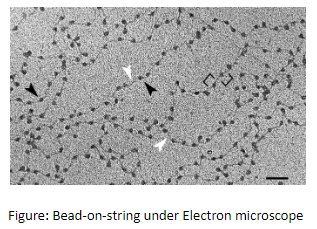
Answer
453k+ views
Hint: The chromatin fibres are formed when the beads-on-string structure in chromatin is packaged. These chromatin fibres further coil and condensed in cell division (metaphase stage) to form chromosomes.
Complete step-by-step answer:
The packaging of DNA helix in eukaryotes is more complex as compared to prokaryotes. There is a set of a positively charged protein called histones. These charges are depending upon the abundance of amino acids residues with charged side chains. The histones are rich arginines and lysines amino acid residues. These amino acid residues carry a positive charge in their side chain. Histones are arranged to form a unit of eight molecules, called histone octamers. The DNA that is negatively charged is wrapped around a histone octamer (positively charged) and forms a structure called a nucleosome. A classic nucleosome contains 200bp of DNA helix. In the nucleus, the nucleosome constitutes the repeating unit of a structure called chromatin. It is a thread-like stained body present in the nucleus. When viewed under electron microscopes the nucleosome in chromatin appeared as a bead-on-string structure. The bead-on-string is packed in the chromatin and forms the chromatin fibres. Further, these fibres condensed and coiled in the metaphase stage of the cell division to form chromosomes. At a higher level, the packaging of chromatin required an additional set of a protein called non-histone chromosomal protein.

Option D is the correct answer.
Note: In prokaryotes such as E.coli, they do have a defined nucleus. Hence the DNA is not scattered throughout the cell. The region called a nucleoid, the negatively charged DNA is held by some positively charged protein. The DNA in the nucleoid is arranged in a large loop held by protein.
Complete step-by-step answer:
The packaging of DNA helix in eukaryotes is more complex as compared to prokaryotes. There is a set of a positively charged protein called histones. These charges are depending upon the abundance of amino acids residues with charged side chains. The histones are rich arginines and lysines amino acid residues. These amino acid residues carry a positive charge in their side chain. Histones are arranged to form a unit of eight molecules, called histone octamers. The DNA that is negatively charged is wrapped around a histone octamer (positively charged) and forms a structure called a nucleosome. A classic nucleosome contains 200bp of DNA helix. In the nucleus, the nucleosome constitutes the repeating unit of a structure called chromatin. It is a thread-like stained body present in the nucleus. When viewed under electron microscopes the nucleosome in chromatin appeared as a bead-on-string structure. The bead-on-string is packed in the chromatin and forms the chromatin fibres. Further, these fibres condensed and coiled in the metaphase stage of the cell division to form chromosomes. At a higher level, the packaging of chromatin required an additional set of a protein called non-histone chromosomal protein.

Option D is the correct answer.
Note: In prokaryotes such as E.coli, they do have a defined nucleus. Hence the DNA is not scattered throughout the cell. The region called a nucleoid, the negatively charged DNA is held by some positively charged protein. The DNA in the nucleoid is arranged in a large loop held by protein.
Recently Updated Pages
If x be real then the maximum value of 5 + 4x 4x2 will class 10 maths JEE_Main

If the coordinates of the points A B and C be 443 23 class 10 maths JEE_Main

What happens when dilute hydrochloric acid is added class 10 chemistry JEE_Main

The quadratic equation whose one root is 2sqrt3 will class 10 maths JEE_Main

If alpha and beta are the roots of the equation x2 class 10 maths JEE_Main

What is the distance between the circumcentre and the class 10 maths JEE_Main

Trending doubts
Fill the blanks with the suitable prepositions 1 The class 9 english CBSE

Which are the Top 10 Largest Countries of the World?

How do you graph the function fx 4x class 9 maths CBSE

Find the value of the expression given below sin 30circ class 11 maths CBSE

The Equation xxx + 2 is Satisfied when x is Equal to Class 10 Maths

Differentiate between homogeneous and heterogeneous class 12 chemistry CBSE

Change the following sentences into negative and interrogative class 10 english CBSE

Difference between Prokaryotic cell and Eukaryotic class 11 biology CBSE

Why is there a time difference of about 5 hours between class 10 social science CBSE




